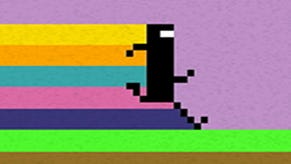Bit. Trip Beat
Dot dot dash.
Today's videogame instruction manuals strain at their staples, pamphlet bibles heavy with back-stories for characters you don't yet care for and detailed explanations of control schemes that sit meaningless on the page. Perhaps then, Bit Trip Beat exists to prove that "Avoid Missing Ball For High-Score" can, even today, still be instruction enough. (Although let's drop the full-stop in "Bit. Trip" lest we all get confused.)
Sure, Pong's heart has been dressed anew: vibrant pinks and purples replace Atari's venerable whitish blocks and that backdrop of mute blackness is now seasoned with stars and comets. Likewise, the tick-tock sonic rhythm of Pong's pixel ball batting back and forth now resounds as timpani in the embellishments of an entire chip tune orchestra, ensuring Bit Trip Beat is as much music game as 8-bit table tennis match.
But the aesthetic progressions are tempered by a purity of purpose. Unlike, say Virtua Tennis 3, you don't avoid missing the ball only to then show off with a showy curve ball, pregnant with backspin. No, you merely twist your Wii remote to control a paddle in order to knock back the pixels fired your way. Miss enough dots and its game over. Hit enough dots and the song plays on, driven by the rhythm of your successes, building to a sonic finale as thrilling as any climactic Rock Band chorus.

The Wii remote is held sideways, your paddle travelling vertically up and down the left-hand side of the screen as you twist it towards and away from your body. Unlike Pong, there is no competing paddle on the right-hand side of the screen. Instead, dots come flying in from off-stage, the space background scrolling away behind as if you're a cubist Vic Viper flying through a proto-Gradius star system. There are no buttons to press, no fussiness to cloud the truth that this videogame, like so many videogames, is entirely about making micro-muscular twitches to knock back the stream of challenges sent your way by its designer.
Two gauges inform you of your progress, each stretching from left to right across the screen. Successful hits fill the gauge at the top, while the bottom one fills when you miss a dot. Fill the top gauge and the game shifts up a gear, increasing your score multiplier and causing the visuals to explode with yet more vivacity, the pitch of sound effects also altering as an aural signifier of your cleverness. But if the bottom gauge fills then the screen drains of all colour and sound, the music's pulse shifting senses from sound to touch, the Wii Remote literally throbbing to communicate the song's tempo while the blips and bleeps sound out through the controller's tinny speaker.



